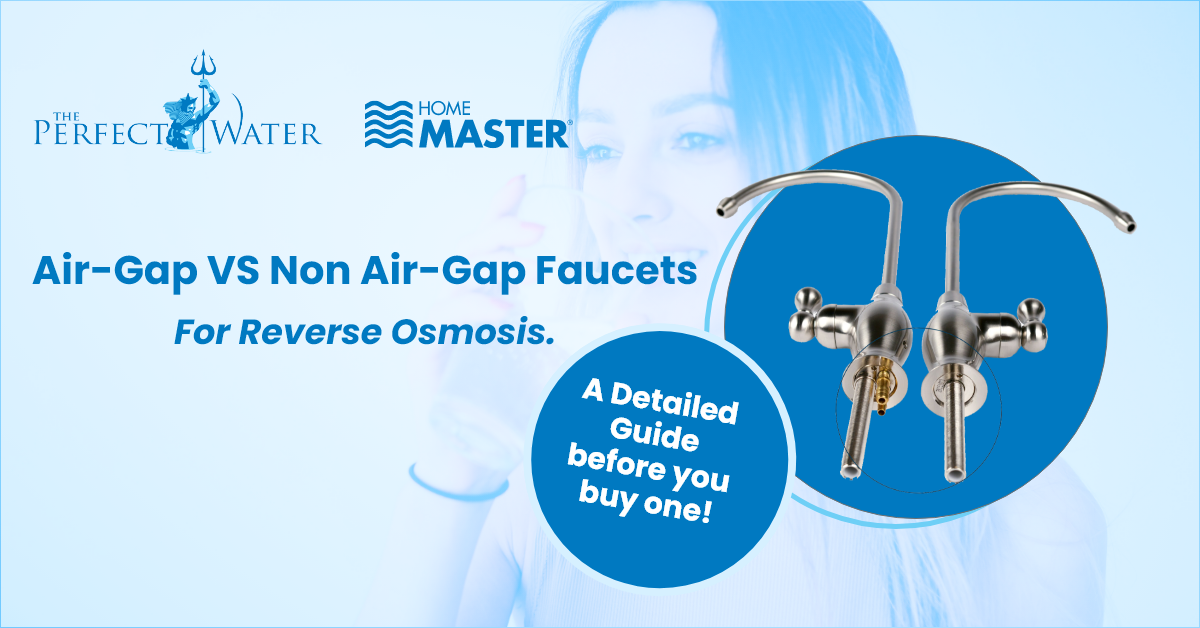
Reverse Osmosis (RO) – A Brief Understanding
Reverse osmosis effectively removes impurities from well or municipal water, known as feed water, by exerting pressure to propel it through a semipermeable membrane. This process allows water to move from the higher concentration region (with more contaminants) of the reverse osmosis (RO) membrane to the lower concentration region (with fewer contaminants), resulting in the production of purified drinking water.
The resultant purified water is referred to as permeate, while the residual concentrated water is commonly known as waste, concentrate, or brine. RO membranes demonstrate a remarkable capacity to selectively reject a substantial majority, ranging from 95% to 99%, of dissolved solutes encompassing organic constituents, and inorganic constituents from the feed water, thus ensuring the potable water is suitable for consumption purposes after filtration.
Benefits of a Home Reverse Osmosis System
-
Clean drinkable water directly from the tap
-
Encourages hydration and improves water intake
-
Environment friendly as it minimizes the packed bottled water
-
Eliminates microplastics found in tap water or bottled water
-
Less expensive than buying bottled water
Reverse Osmosis (RO) – How does it work?
Reverse Osmosis (RO): Filtration Process
The reverse osmosis (RO) system effectively removes sediment and chlorine from water by utilizing pre-filters to initiate the process, followed by applying pressure to force the water through a semipermeable membrane, effectively separating dissolved solids. Contaminants which would otherwise foul the RO membrane must be (pre)filtered. Iron, chlorine/chloramines, sediment, high hardness, are common membrane foulants. Subsequently, the purified water undergoes further refinement as it transits a post-filter, improving the drinking water quality before it reaches a dedicated faucet.
Home Master Reverse Osmosis (RO) systems are available with a patented remineralization system to restore lost calcium and magnesium minerals for tastier and healthier drinking water.
Reverse Osmosis (RO) Faucets
A Reverse Osmosis (RO) faucet is a specialized faucet designed to connect with a Reverse Osmosis (RO) water filtration system to dispense the purified water produced by the system.
Typically made from metal and/or plastic, these faucets comprise a base and shank installed into a sink-hole, a lever or dial mechanism to open and close the valve and enable water flow control, and a curved spout facilitating the dispensation of the filtered water into a sink basin. Modern metal RO Faucets are specially formulated with lead-free metals, or are lined, to prevent leaching if/when the RO water becomes mildly acidic.
These faucets are purposefully designed to integrate with the reverse osmosis system seamlessly, necessitating their placement adjacent to standard sink faucets, in an available or newly drilled sink-hole. A complete range of under sink reverse osmosis RO faucets are available here in various styles, finishes, levels of excellence, performance country of manufacture. Home Master Standard, Luxury standard, and Waterstone brand faucets are Made in the USA, and subject to US regulations.
Importance of faucets in RO systems
Faucets are pivotal in reverse osmosis (RO) systems, serving as the on-demand purified water dispenser tap. These faucets ensure convenient and easy filtered dispensing, eliminating the need for a refrigerator water/ice center connection, free standing water cooler, or other dispensing appliance. Additionally, RO Faucets are available in both Hot and Cold configurations for connection to an undersink hot tank. Such faucets are “non-airgap” and “vented”.
Faucets are integral to under-sink home RO systems and are usually included in the installation kit.
Reverse Osmosis (RO) Faucets: Different Types and Uses
Reverse Osmosis (RO) systems come with two main types of faucets and one sub type, based on their intended uses and features.
-
Non-Air Gap RO Faucets
-
Vented Non-Air Gap RO Faucets
-
In most RO system installation kits Non-air gap RO facets are the standard faucet style. However, Air gap RO faucets are not uncommon. Air gap and non-air gap faucets both dispense water similarly; except that an Air Gap Faucet has been made to create a physical siphon break or gap, from the RO system itself and the sink drain by dropping water from one tube into another through the air to prevent backflow. This ‘backflow prevention’ method is called an ‘air gap’ mechanism, whereby in the case of backflow, it directs the backflow water out of the faucet’s body above the countertop out of a window and into the sink basin provided the RO Faucet has been mounted on the sink. One of the detrations of the Air Gap design is that it must be mounted on the sink’s surface and not use in an undermount configuration where the faucet would be on top of the countertop. If one mounts am Air Gap RO Faucet on the countertop with an undermount sink, and if the system backs up the resulting backflow will be ejected on the countertop where it can spread out and flow to the flooring, damaging the flooring or creating a slip-and-fall hazard. This problem can be ameliorated with an Air Gap Catch®.
Air Gap RO Faucets
The type of RO faucet that uses air to create a physical siphon break to ensure backflow water from the home’s drain system won’t back-up into the reverse osmosis system, and in rare cases back into the home’s water supply. These air-gap RO faucets typically have three connections on the faucet’s underside, below the sink; one is the clean water input usually ¼”, and the other two are for the RO system’s waste water, with one ¼” drain-input, and ⅜” drain output.
Advantages
-
Integrated backflow prevention
-
Prevents drain water ‘backflow’ into the RO system
-
Qualifies and passes all local plumbing codes for areas where an air gap faucet is mandatory to use with a RO system
Disadvantages
-
Unwise to use with undermount sinks
-
Often makes gurgling noises
-
Requires your home to have sufficient drainage capacity, otherwise it will backflow out of the air gap window, which is often mistaken for a defect in the system, when it's actually due to inadequate or clogged home drainage plumbing
Non-air gap RO Faucets
Non-Air gap RO Faucets use a simpler design with only one connection on the faucet’s underside, below the sink. The sole connection is for the clean water and is usually ¼”, but is a ⅜” connection in Home Master RO systems for greater flow. When using a non-air gap RO faucet with a RO system, one must ensure separate backflow prevention provisions are made. This is typically accomplished with the use of a check valve on the drain line, use of a permeate pump, or garbage disposal drain adapter.
Advantages
-
Simpler installation
-
Quieter/silent operation
-
Works well with surface mount and under mount sinks
Disadvantages
-
Separate backflow prevention required otherwise drain water can backflow into the RO system
-
Separate backflow prevention required in areas where plumbing codes require an air gap
Vented non-air gap RO Faucets
Vented non-air gap RO Faucets are primarily used in conjunction with an under sink hot tank and are available in more common dual handle Hot and Cold, and less common single handle Hot Only styles. The Hot and Cold vented non-air gap RO faucet has three connections on the faucet’s underside, below the sink. One is the clean water input, usually ¼”, and the other two connect to the hot tank, with one ¼” hot tank (it's actually cold water at this point) input, and ⅝” hot water output to the RO faucet. The “venting” portion takes place on the hot side where the hot water line is vented to the air, so that as the hot water is dispensed and the cold RO water is pushed into the hot tank, it has room to expand as that cold RO water is heated. Without the vent, the hot tank would burst. One can see this in action as a vented non-air gap RO Faucet will appear to flow/drip long after its water valve is closed. It's not a defective valve, rather it's the new cold water being heated and expanding out of the system, safely and by design, into the sink basin.
Choosing the Right Faucet for Your Reverse Osmosis (RO) System
The Reverse Osmosis (RO) System should meet and fulfill the requirements dictated by the application (think well water vs city water, and available water pressure) to produce purified water supply at home. Usually, the RO unit comes with a standard non-air gap faucet for installation at the kitchen sink. In some areas, the plumbing regulations require air-gap RO to pass the plumbing codes. In those cases an auxiliary backflow predator or drain connection must be used with a non-air gap faucet.
A wide variety of color, finish, and materials options are available to match any kitchen faucet and home decor. Home Master, the leading RO system provider, brings a complete range of Air Gap RO Faucets and non-Air Gap RO Faucets for home use.
Installation and Maintenance Tips
The Reverse Osmosis (RO) systems with faucets usually have an easy-to-DIY installation feature that enables users to install it quickly. However, there is a slight difference in installing the non-air gap and air-gap faucet installation due to the difference in the hole at the sink and tube. The Home Master RO Systems have installation guide videos for reference and planning. There are some tips to keep in mind for installation and maintenance, as given here.
-
Make sure the installation complies with the local plumbing regulations
-
Locate the RO faucet off to the side of the sink away from messy or potentially contaminating activities like cleaning chicken
-
Air-gap faucets needs a 1” - 1 ⅜” hole
-
Air-gap faucets are likely to eject drain water; use them on surface mount sinks only
-
If local plumbing regulations allow, then use an in-line check valve in the drain line and/or a garbage disposal dishwasher drain adapter for backflow prevention with non-air gap faucets
-
Maintain RO membrane and filters regularly, as clogs will increase drain water production
-
Follow the recommended annual RO system sanitizing routine
Final words
In conclusion, it is imperative to understand the differences between the available RO Faucet styles and functioning for each individual application. In other words - get the right tool for the job. Air-gap faucets and non-air gap faucets have differences which will dictate the suitability of a given application. Considering water flow, compatibility, durability, and aesthetics, one can ensure an optimal and efficient RO system and the best RO faucet to meet their needs. Check the Home Master RO system buying guide to get more information.
This article sheds light on the distinctions in RO Faucet features to facilitate informed decision-making, empowering individuals to navigate the extensive range of faucet options available in the market and making the correct choice to ensure a great experience with their new home RO System and the improved hydration with healthier purified drinking water.
